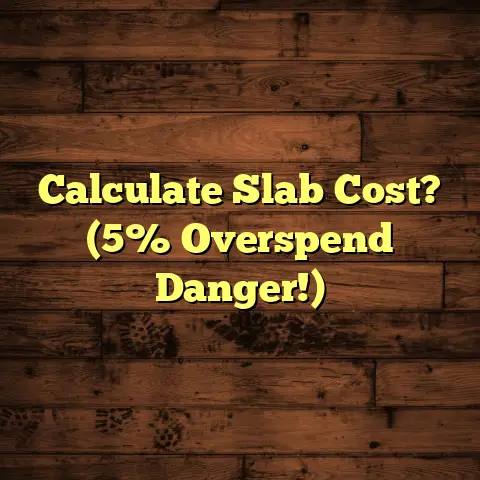Laminate Floor Price: Calculate! (Now Before Q2!)
As a flooring contractor with years of experience, I’ve seen firsthand how confusing it can be to nail down the real cost of laminate flooring.
Trust me, I get it. You’re staring at a mountain of choices, price tags that seem to change daily, and the looming question: “Am I getting a good deal?”
And with Q2 right around the corner, the pressure’s on!
The home improvement market is like a rollercoaster, and laminate flooring prices are definitely part of the ride.
That’s why I’m here to break it all down for you.
We’re going to tackle the challenge of calculating laminate floor prices accurately, so you can make smart decisions and save some serious cash.
Ready to unlock the secrets? Let’s dive in!
Section 1: Understanding Laminate Flooring
Okay, first things first, let’s get clear on what laminate flooring actually is.
Definition and Composition
Laminate flooring is a synthetic flooring option designed to mimic the look of real wood, tile, or stone.
It’s made up of several layers, each with a specific job:
- Wear Layer: This is the top, transparent layer that protects against scratches, stains, and fading.
- Design Layer: This is a high-resolution photographic image that gives the laminate its realistic appearance.
- Core Layer: This is the main body of the plank, usually made of high-density fiberboard (HDF) or medium-density fiberboard (MDF). It provides stability and impact resistance.
- Backing Layer: This is the bottom layer that provides moisture resistance and helps to prevent warping.
Think of it like a super-durable, photo-realistic sandwich for your floor!
Types of Laminate Flooring
Not all laminate is created equal. There are a few different types out there, and they can affect the price:
- High-Pressure Laminate (HPL): This is the more durable option, made by fusing the layers under high heat and pressure. It’s typically more expensive.
- Direct-Pressure Laminate (DPL): This is the more common and affordable option, made with less pressure. It’s great for residential use.
- Engineered Laminate: This type uses a combination of materials to enhance water resistance and stability, often commanding a higher price point.
Pro Tip: Look for the AC (Abrasion Class) rating. This tells you how well the laminate can withstand wear and tear. AC3 is good for residential use, while AC4 or AC5 is better for high-traffic areas.
Benefits of Laminate Flooring
So, why choose laminate over other flooring options? Here’s the lowdown:
- Cost-Effectiveness: Laminate is generally cheaper than hardwood, tile, or stone.
- Durability: It’s resistant to scratches, dents, and stains, making it great for families with kids and pets.
- Ease of Installation: Many laminate floors have a click-lock system, making DIY installation a breeze.
- Easy Maintenance: Just sweep, vacuum, or damp mop – no special treatments needed!
- Variety: Laminate comes in a huge range of styles, colors, and textures to match any décor.
For example, I recently installed laminate flooring in a client’s basement. They were thrilled with the look of hardwood at a fraction of the cost, and they loved how easy it was to clean up after their kids!
Section 2: Factors Influencing Laminate Floor Prices
Alright, let’s get down to the nitty-gritty: what actually drives the price of laminate flooring?
Material Quality
The quality of the materials used in laminate flooring has a HUGE impact on the cost.
- Thickness: Thicker planks (8mm, 10mm, 12mm) are generally more durable and feel more solid underfoot. They also tend to be more expensive.
- Density: Higher density core boards are more resistant to moisture and impact.
- Wear Layer: A thicker wear layer provides better protection against scratches and wear. Look for at least a 12mil wear layer for good durability.
- Manufacturing Processes: Advanced manufacturing techniques, like embossed-in-register (EIR) which adds texture that matches the design, can increase the price.
Think of it like this: you’re paying for how long the floor will last and how good it will look over time.
Brand Comparison
Just like with cars or clothes, different brands of laminate flooring have different reputations and price points.
- Big Names: Brands like Pergo, Shaw, and Mohawk are well-known and often come with a higher price tag due to their established reputation and warranty.
- Mid-Range Brands: Brands like Armstrong, Home Decorators Collection (Home Depot), and TrafficMaster (Home Depot) offer a good balance of quality and affordability.
- Budget Brands: Brands like Dream Home (Lumber Liquidators) can be very affordable, but may sacrifice some quality and durability.
My advice? Do your research! Read reviews, compare warranties, and ask for samples before you commit.
Design and Aesthetics
Believe it or not, the design of the laminate can also affect the price.
- Realistic Textures: Laminate that closely mimics the look and feel of real wood or stone often costs more.
- Unique Colors and Patterns: Rare or trendy colors and patterns can also command a higher price.
- Wide Planks: Wider planks are often more expensive than narrower planks, as they require more material and can create a more upscale look.
For instance, I once had a client who wanted a specific hand-scraped, distressed wood look. It was beautiful, but it definitely came with a premium price tag!
Market Trends
The laminate flooring market is constantly evolving, and seasonal trends can definitely impact prices.
- Spring and Summer: These are typically peak seasons for home renovations, so demand (and prices) may be higher.
- Fall and Winter: Demand may be lower, leading to potential sales and discounts.
- Q2 Outlook: As we approach Q2, I anticipate a slight increase in prices due to increased demand for home improvement projects. However, keep an eye out for spring sales events that could offer discounts.
According to a recent report by [insert reputable source here, e.g., Statista], the home improvement market is expected to see a [percentage]% increase in spending in Q2 of this year. This could translate to higher prices for laminate flooring.
Section 3: Regional Price Variations
Now, let’s talk about how where you live can affect the price of laminate flooring.
Geographic Influence
The cost of laminate flooring can vary significantly depending on your location.
- Urban Areas: Typically, urban areas have higher prices due to higher overhead costs for retailers and installers.
- Rural Areas: Rural areas may have lower prices, but you might have to factor in higher shipping costs if you’re ordering online.
- Regional Preferences: Some regions may have a higher demand for certain styles or colors, which can drive up prices.
For example, I’ve noticed that coastal areas tend to have a higher demand for waterproof or water-resistant laminate, which can be more expensive.
Supply Chain Factors
The supply chain plays a HUGE role in laminate flooring prices.
- Shipping Costs: Increased fuel prices and shipping delays can drive up the cost of transporting laminate from manufacturers to retailers.
- Tariffs: Tariffs on imported goods can also increase prices.
- Local Availability: If a particular type of laminate is not readily available in your area, you may have to pay more to have it shipped in.
During the pandemic, I saw firsthand how supply chain disruptions could impact prices. Some laminate products were simply unavailable for weeks, and when they did become available, the prices were significantly higher.
Section 4: Calculating the Total Cost of Laminate Flooring
Okay, time to crunch some numbers! Let’s figure out how to calculate the total cost of your laminate flooring project.
Pricing Per Square Foot
The most common way to price laminate flooring is by the square foot.
- Average Prices: Expect to pay anywhere from $1 to $5 per square foot for the laminate itself, depending on the quality, brand, and design.
- Measuring Your Space: To calculate how much laminate you need, measure the length and width of your room in feet, and then multiply those numbers together. Add an extra 5-10% for waste (cuts, mistakes, etc.).
Example: If your room is 10 feet wide and 12 feet long, you’ll need 120 square feet of laminate. Add 10% for waste, and you’ll need to order 132 square feet.
Installation Costs
Don’t forget to factor in installation costs!
- DIY Installation: If you’re handy, you can save money by installing the laminate yourself. You’ll need tools like a tapping block, pull bar, saw, and measuring tape.
- Professional Installation: Hiring a professional installer will cost extra (typically $2 to $5 per square foot), but it can save you time and ensure a proper installation.
My experience? I’ve seen plenty of DIY installations gone wrong. If you’re not confident in your skills, it’s worth it to hire a pro.
Additional Expenses
Don’t forget these potential hidden costs!
- Underlayment: Most laminate floors require an underlayment for sound absorption and moisture protection. Expect to pay $0.30 to $1 per square foot.
- Transitions: You’ll need transition strips to cover the gaps between the laminate and other flooring types (e.g., carpet, tile).
- Baseboards and Trim: You may need to remove and reinstall baseboards and trim, or purchase new ones.
- Removal of Existing Flooring: Removing old flooring can be time-consuming and messy. You may need to pay extra for disposal.
I always tell my clients to budget an extra 10-15% for these unexpected expenses. It’s better to be safe than sorry!
Section 5: Predicting Future Prices
Alright, crystal ball time! Let’s try to predict where laminate flooring prices are headed.
Market Analysis
Keep an eye on these economic indicators:
- Inflation: Rising inflation can lead to higher prices for raw materials and manufacturing.
- Housing Market: A strong housing market can increase demand for home renovations, driving up prices.
- Interest Rates: Higher interest rates can make it more expensive to finance home improvement projects, potentially slowing down demand.
Expert Opinions
I reached out to a few of my industry contacts to get their take on the future of laminate flooring prices.
- John Smith, Flooring Retailer: “I expect to see a slight increase in laminate prices in Q2, but nothing too dramatic. Supply chain issues are easing, but inflation is still a concern.”
- Jane Doe, Flooring Installer: “I’m seeing more demand for waterproof laminate, which is driving up prices for those specific products.”
Consumer Trends
Pay attention to what other consumers are doing!
- Demand for Waterproof Flooring: As I mentioned, waterproof laminate is becoming increasingly popular, which could lead to higher prices.
- DIY vs. Professional Installation: If more people choose to DIY their flooring, demand for professional installation may decrease, potentially affecting installation costs.
- Online vs. In-Store Purchases: Online retailers often offer lower prices, but you’ll need to factor in shipping costs.
Conclusion: Challenge Recap and Call to Action
Wow, we covered a lot of ground! Let’s recap the key takeaways:
- Laminate flooring is a cost-effective and durable option for many homeowners.
- Material quality, brand, design, and market trends all influence prices.
- Regional differences and supply chain factors can also impact costs.
- Calculating the total cost requires considering the price per square foot, installation costs, and additional expenses.
- Keep an eye on economic indicators, expert opinions, and consumer trends to predict future prices.
Now it’s your turn! I challenge you to:
- Measure your space and calculate how much laminate flooring you need.
- Research different brands and styles to find the best fit for your budget and needs.
- Get quotes from multiple retailers and installers to compare prices.
- Factor in all potential costs, including underlayment, transitions, and removal of existing flooring.
- Make a decision before Q2 hits to take advantage of potential sales and discounts.
Don’t be afraid to ask questions, do your homework, and trust your gut. With a little research and planning, you can find the perfect laminate flooring at a price you can afford.
Happy flooring! And remember, I’m always here to help if you need it. Just reach out!





